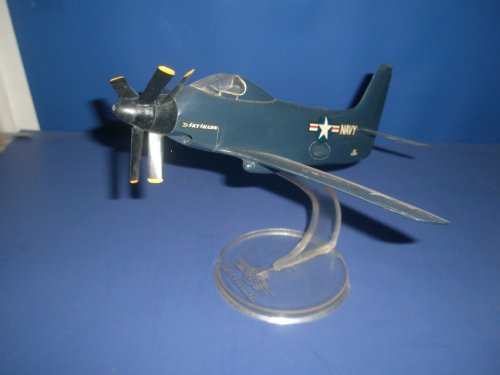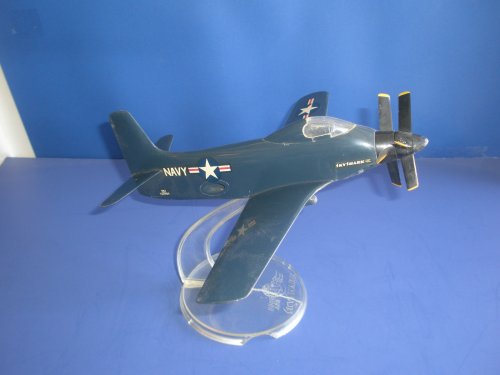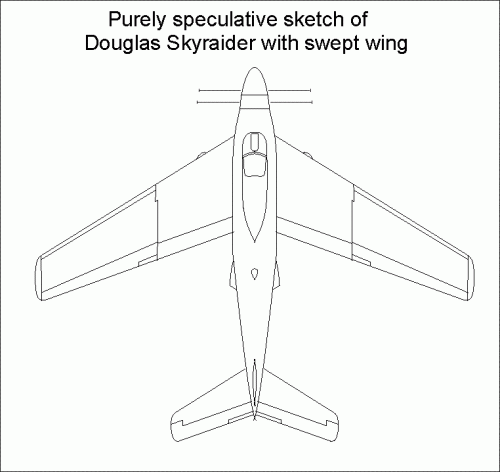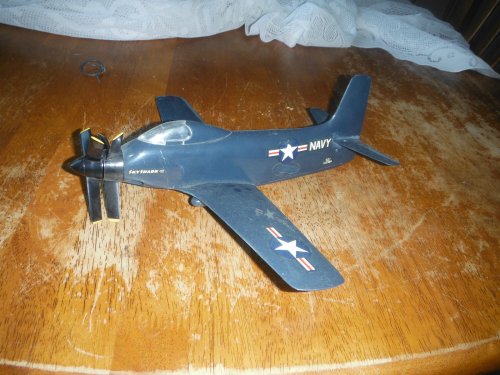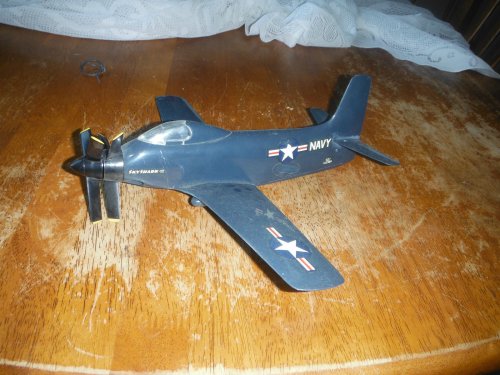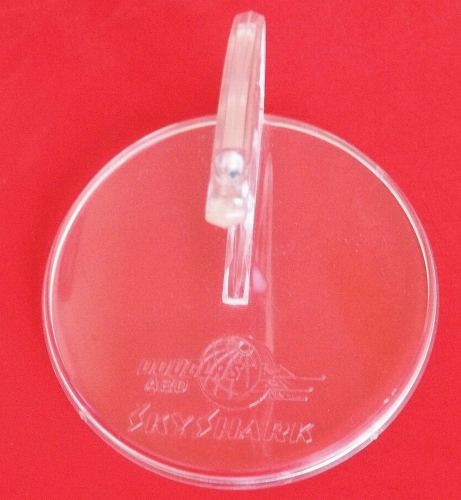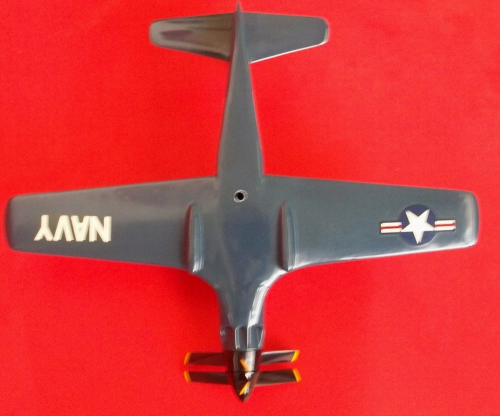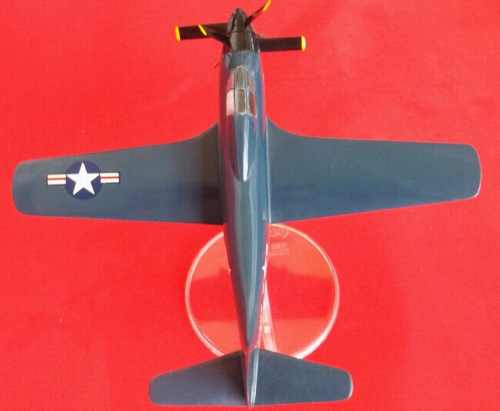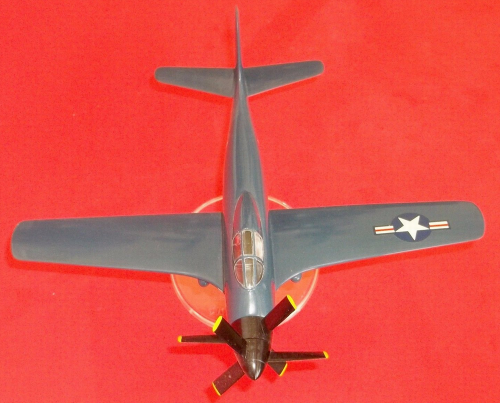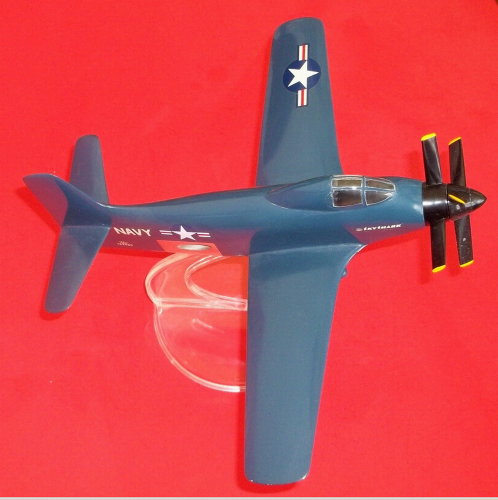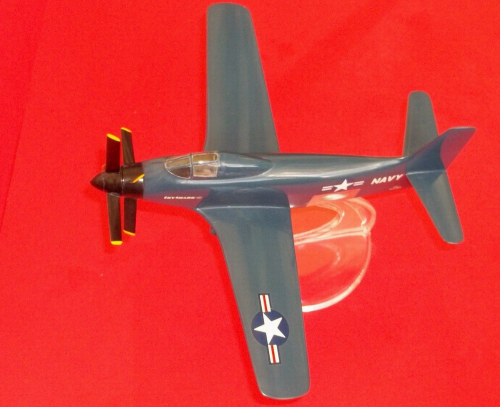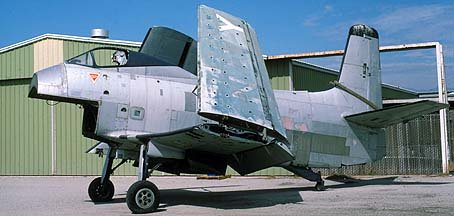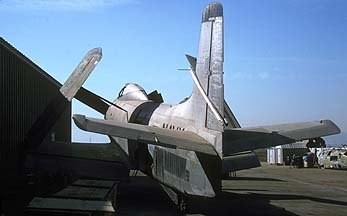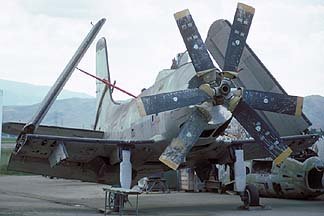You are using an out of date browser. It may not display this or other websites correctly.
You should upgrade or use an alternative browser.
You should upgrade or use an alternative browser.
Douglas XA2D-1 Skyshark
- Thread starter hesham
- Start date
- Joined
- 18 March 2008
- Messages
- 3,529
- Reaction score
- 978
Jemiba said:At least the Fairey Gannet with its Bristol Siddeley Double Mamba
could be regarded as a proof, that it isn't the basic concept, that
is flawed.
The problem with twin packs is building a gearbox sufficiently robust enough to absorb all the torque within the volume and weight margins of a single engine unit.
The Double Mamba in its first marquee (1949) produced only 2,950 hp while at the same time the T40 was supposed to be producing 5,500 hp. By the 1960s Armstrong Siddeley had Double Mambas turning out 3,875 hp but still nowhere near the T40 objective. The PT6T-3 only produces 1,800 hp. So neither engine has a gearbox in the T40’s league even with the benefit of decades of engineering.
Abraham Gubler said:Jemiba said:At least the Fairey Gannet with its Bristol Siddeley Double Mamba
could be regarded as a proof, that it isn't the basic concept, that
is flawed.
The problem with twin packs is building a gearbox sufficiently robust enough to absorb all the torque within the volume and weight margins of a single engine unit.
The Double Mamba in its first marquee (1949) produced only 2,950 hp while at the same time the T40 was supposed to be producing 5,500 hp. By the 1960s Armstrong Siddeley had Double Mambas turning out 3,875 hp but still nowhere near the T40 objective. The PT6T-3 only produces 1,800 hp. So neither engine has a gearbox in the T40’s league even with the benefit of decades of engineering.
If I remember correctly, each power unit of the Double Mamba turned one of the propellers. There wasn't a common gearbox that turned both propellers, which was the tricky part, in part because of the clutches involved but mainly because it doubled the amount of torque that part of the gearbox had to accommodate. If one engine failed or was shut down (for better endurance), its propeller was feathered. I saw a Gannet landing at Sangley Point that way one day in the mid 1950s.
saturncanuck
Any landing you can walk away from, is a good one.
Jemiba said:At least the Fairey Gannet with its Bristol Siddeley Double Mamba
could be regarded as a proof, that it isn't the basic concept, that
is flawed.
The exception that makes the rule?
- Joined
- 18 March 2008
- Messages
- 3,529
- Reaction score
- 978
Tailspin Turtle said:If I remember correctly, each power unit of the Double Mamba turned one of the propellers. There wasn't a common gearbox that turned both propellers,
First part right, second not. The Double Mamba had a common gearbox but each engine drived its own blade in the counter rotating set. Which avoided the duplication of a engine gearbox and a counter rotating propeller gearbox. The starboard engine drove the front blade and so on. This enabled both Double Mambas to be started with a single explosive engine starter. The starboard engine would be started and its prop used to windmill the aft prop and start the port engine without external assistance. If the starboard engine didn't start another Gannet would position in front of the stalled Gannet and use its prop wash to windmill the engine started - at least in the RAN which always did things on flight decks in exciting ways... Of course if the Double Mamba was a 5,500 lb unit like the T50 then the torque of a single engine through a four bladed propeller would probably be too much.
- Joined
- 21 May 2006
- Messages
- 3,002
- Reaction score
- 2,278
If the starboard engine didn't start another Gannet would position in front of the stalled Gannet and use its prop wash to windmill the engine started - at least in the RAN which always did things on flight decks in exciting ways..
An interesting and very novel way of achieving a means to an end!
Its a great pity that this knowledge and experience is now all but lost in the RAN!!!!!
Abraham thanks for sharing this great piece of information and typical Aussie way of adapting and overcoming of a problem.
There's a Gannet down at the Moorabin Airport aircraft museum, which I have been meaning to go and look at for the past 5-years!
I think you have given me reason to pull my finger out!!!
Regards
Pioneer
I always wondered why an alternative engine like the Pratt & Whitney T34 was not considered. It had the same performance spectrum and didn't have a troublesome two-engines-and-gearbox layout. First run was in 1950 - so just in time for a potential production start of the the Skyshark in 1955 or so.
- Joined
- 25 June 2009
- Messages
- 14,753
- Reaction score
- 6,145
Same here, and it's not the only time this happened. I wonder if this may not have something to do with the fact that they were kind of developing the aircraft FOR a certain type of engine, not the other way around, and so when the engine failed there was no need to pursue the efforts...
- Joined
- 18 March 2008
- Messages
- 3,529
- Reaction score
- 978
Basil said:I always wondered why an alternative engine like the Pratt & Whitney T34 was not considered. It had the same performance spectrum and didn't have a troublesome two-engines-and-gearbox layout. First run was in 1950 - so just in time for a potential production start of the the Skyshark in 1955 or so.
The twin pack engine gives you the ability to turn one engine off and cruise with half the fuel consumption for long endurance for patrol. It also gives you dual engine redundancy which for early turbines and over water operations is a huge boost to safety. Also the twin pack engine has lower height than a single engine of twice the power (as each of the twin's units). So you can design an aircraft like the A2D with the cockpit above the engine giving the pilot excellent over nose view for carrier landings (and close air support missions).
- Joined
- 11 March 2006
- Messages
- 8,625
- Reaction score
- 3,804
I think that, apart from the pure technical reasons, with the rise of the Skyhawk
a type like the Skyshark was seen as superfluous. And as procurement of combat
aircraft isn't a totally rationale affair, fighting props may already had lost favour
with the USN.
a type like the Skyshark was seen as superfluous. And as procurement of combat
aircraft isn't a totally rationale affair, fighting props may already had lost favour
with the USN.
The T34 wasn't being developed with a contra-rotating propeller, which BuAer was probably insisting upon due to P-factor and torque effects on a deck run and more importantly, a wave-off. BuAer reportedly gave P&W a contract to develop the gearbox for one (the T34 was a "Navy" engine) in 1950, but the effort was apparently canceled. My guess is that the Navy decided that the AD was good enough for its purposes, which it proved to be for many years. It may have also helped that the small carriers that the A2D was intended to operate from were having to be phased out for budget reasons.
The A4D wasn't a replacement for the AD/A2D although it was started on funds slated for the A2D program. It supplemented the atomic-bomb delivery portion of the AD's mission assignments. The payload and endurance provided by a propeller-driven airplane for close-air support was hard to equal with a jet. (The A4D had three pylons, at least one of which was usually needed for an external fuel tank, and two 20mm cannons with a token amount of ammunition; the A2D had those three pylons plus 22 smaller ones for rockets and small bombs and twice as many 20 mm cannon each with twice the rounds of ammunition per gun.) The AD-5N was finally replaced by the A2F (A-6) in the mid 1960s. The AD-6/7 was finally replaced by the A-7 in the mid 1960s.
The A4D wasn't a replacement for the AD/A2D although it was started on funds slated for the A2D program. It supplemented the atomic-bomb delivery portion of the AD's mission assignments. The payload and endurance provided by a propeller-driven airplane for close-air support was hard to equal with a jet. (The A4D had three pylons, at least one of which was usually needed for an external fuel tank, and two 20mm cannons with a token amount of ammunition; the A2D had those three pylons plus 22 smaller ones for rockets and small bombs and twice as many 20 mm cannon each with twice the rounds of ammunition per gun.) The AD-5N was finally replaced by the A2F (A-6) in the mid 1960s. The AD-6/7 was finally replaced by the A-7 in the mid 1960s.
- Joined
- 18 March 2008
- Messages
- 3,529
- Reaction score
- 978
Jemiba said:I think that, apart from the pure technical reasons, with the rise of the Skyhawk
a type like the Skyshark was seen as superfluous. And as procurement of combat
aircraft isn't a totally rationale affair, fighting props may already had lost favour
with the USN.
This may be a logical assumption to make but is not supported by the actual timeline, facts and events. If the T40 gearbox had not failed and the A2D Skyshark had entered production it would not have competed with the A4D Skyhawk but rather the later models of the AD Skyraider (the ~800 AD-6s and 7s). By February 1951 the US Navy had 341 A2Ds under order from Douglas and these probably would have entered service around 1953-54. While the A4D would have replaced the A2D in production from around 1957 the A2Ds would have stayed in service for some time and would have performed very well in VietNam.
Abraham Gubler said:[While the A4D would have replaced the A2D in production from around 1957 the A2Ds would have stayed in service for some time and would have performed very well in VietNam.
There's no doubt that the "Sandy" A-1's were a downed pilot's best friend during Vietnam. No airplane could hope to truly replace them in the CSAR mission, even when the A-7 started to perform the role. The Skyshark was definitely suited for performing the Skyraider's CSAR mission, with the extra speed that the T40 could have provided if it worked as advertised. My biggest question would have been whether the T40 was more vulnerable to small arms fire than the R3350.
Had the Skyshark seen production, it's likely that the A-6 requirement would have been delayed. It's also possible that Douglas would have developed a multi-seat Skyshark in the same vein as the AD-5 Skyraider.
- Joined
- 18 March 2008
- Messages
- 3,529
- Reaction score
- 978
CFE said:My biggest question would have been whether the T40 was more vulnerable to small arms fire than the R3350.
The A2D would have been a lot more survivable than the AD. Firstly it could fly a lot faster (433 knots vs 293 knots) and would have a lot better acceleration. So it’s going to be much harder to hit than a AD. Most ground to air hits come from the front arc (or rear) as it’s much easier to hit an airplane flying straight at you (or away). Frontal hits on the AD are mostly going to hit the engine and most of them the front row cylinder heads. On the A2D frontal hits are going to hit the gear box and not the turbines which are behind the gear box. Gear boxes tend to be encased in very thick and strong steel boxes so a pretty invulnerable to most hits. Also if the frontal hit is oblique enough to miss the gear box and hit a turbine the A2D has two of them so if one fails the other can get you home (hopefully).
CFE said:Had the Skyshark seen production, it's likely that the A-6 requirement would have been delayed. It's also possible that Douglas would have developed a multi-seat Skyshark in the same vein as the AD-5 Skyraider.
I doubt that a lot. Firstly because of the turbine exhausts the A2D does not have a lot of convenient unused volume in the fuselage. So unlike the AD you can’t easily modify it with extra crew and radars for the night attack mission. The A2D did however have its own nose radar so could presumably accurately drop bombs at night without modification. Also no multi-seat A2D is going to be able to offer the penetration performance of a jet powered A2F or carry the two radars for the all weather strike.
hole in the ground
ACCESS: Secret
- Joined
- 6 August 2008
- Messages
- 235
- Reaction score
- 23
It is possible to move turbine exhausts to create extra internal volume thoughI doubt that a lot. Firstly because of the turbine exhausts the A2D does not have a lot of convenient unused volume in the fuselage. So unlike the AD you can’t easily modify it with extra crew and radars for the night attack mission.

Why would they use thick steel cases for gearboxes in an aircraft? If aluminum was good enough for engine cases at that time & prior, why wouldn't it be good enough for gearboxes?
Abraham Gubler said:CFE said:My biggest question would have been whether the T40 was more vulnerable to small arms fire than the R3350.
The A2D would have been a lot more survivable than the AD. Firstly it could fly a lot faster (433 knots vs 293 knots) and would have a lot better acceleration. So it’s going to be much harder to hit than a AD. Most ground to air hits come from the front arc (or rear) as it’s much easier to hit an airplane flying straight at you (or away). Frontal hits on the AD are mostly going to hit the engine and most of them the front row cylinder heads. On the A2D frontal hits are going to hit the gear box and not the turbines which are behind the gear box. Gear boxes tend to be encased in very thick and strong steel boxes so a pretty invulnerable to most hits. Also if the frontal hit is oblique enough to miss the gear box and hit a turbine the A2D has two of them so if one fails the other can get you home (hopefully).
CFE said:Had the Skyshark seen production, it's likely that the A-6 requirement would have been delayed. It's also possible that Douglas would have developed a multi-seat Skyshark in the same vein as the AD-5 Skyraider.
I doubt that a lot. Firstly because of the turbine exhausts the A2D does not have a lot of convenient unused volume in the fuselage. So unlike the AD you can’t easily modify it with extra crew and radars for the night attack mission. The A2D did however have its own nose radar so could presumably accurately drop bombs at night without modification. Also no multi-seat A2D is going to be able to offer the penetration performance of a jet powered A2F or carry the two radars for the all weather strike.
Kevin Renner
ACCESS: Confidential
- Joined
- 6 November 2007
- Messages
- 102
- Reaction score
- 12
hole in the ground said:It is possible to move turbine exhausts to create extra internal volume thoughI doubt that a lot. Firstly because of the turbine exhausts the A2D does not have a lot of convenient unused volume in the fuselage. So unlike the AD you can’t easily modify it with extra crew and radars for the night attack mission.


Still one of the ugliest A/C ever built
- Joined
- 3 June 2006
- Messages
- 3,094
- Reaction score
- 3,963
Here the pictures at the SDASM Archives.
Link:
http://www.flickr.com/photos/sdasmarchives/4564061259/
Link:
- http://www.flickr.com/search/?ss=2&w=49487266%40N07&q=Skyshark&m=text
- http://www.flickr.com/search/?ss=2&w=49487266%40N07&q=A2D&m=text
- http://www.flickr.com/search/?s=int&w=all&q=XA2D-1&m=text
http://www.flickr.com/photos/sdasmarchives/4564061259/
Douglas A2D Skyshark model found on eBay. Allyn?
URL:
http://www.ebay.com/itm/Vintage-Douglas-A2D-Skyshark-Allyn-Desk-Model-Topping-Models-/120976436046?pt=LH_DefaultDomain_0&hash=item1c2ac1eb4e
URL:
http://www.ebay.com/itm/Vintage-Douglas-A2D-Skyshark-Allyn-Desk-Model-Topping-Models-/120976436046?pt=LH_DefaultDomain_0&hash=item1c2ac1eb4e
Attachments
-
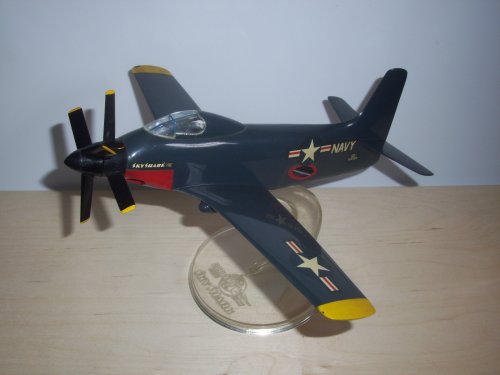 $(KGrHqZ,!owF!F0PPH!IBQPBkEY+ZQ~~60_57.JPG335 KB · Views: 255
$(KGrHqZ,!owF!F0PPH!IBQPBkEY+ZQ~~60_57.JPG335 KB · Views: 255 -
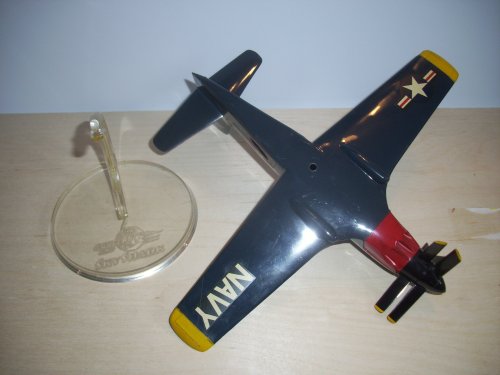 $(KGrHqV,!o0F!HcnjwrFBQPBihHV5g~~60_57.JPG378.1 KB · Views: 82
$(KGrHqV,!o0F!HcnjwrFBQPBihHV5g~~60_57.JPG378.1 KB · Views: 82 -
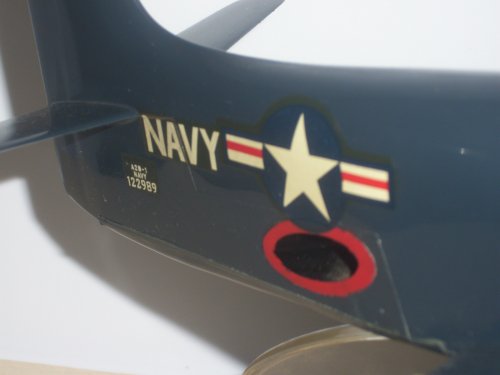 $T2eC16hHJGwE9n)yVUMhBQPBkVDk5Q~~60_57.JPG290 KB · Views: 59
$T2eC16hHJGwE9n)yVUMhBQPBkVDk5Q~~60_57.JPG290 KB · Views: 59 -
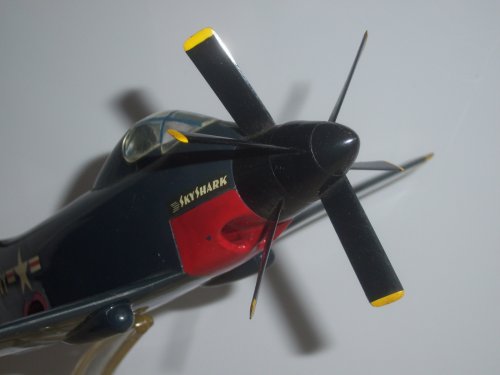 $T2eC16R,!yEE9s5jFRLHBQPBj1b+jg~~60_57.JPG305 KB · Views: 58
$T2eC16R,!yEE9s5jFRLHBQPBj1b+jg~~60_57.JPG305 KB · Views: 58 -
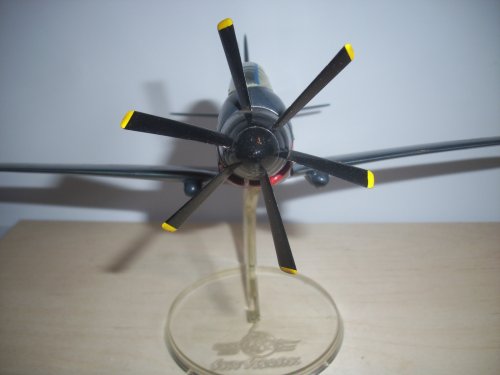 $T2eC16N,!)QE9s3HD)Y(BQPBlVEN0Q~~60_57.JPG296.1 KB · Views: 73
$T2eC16N,!)QE9s3HD)Y(BQPBlVEN0Q~~60_57.JPG296.1 KB · Views: 73 -
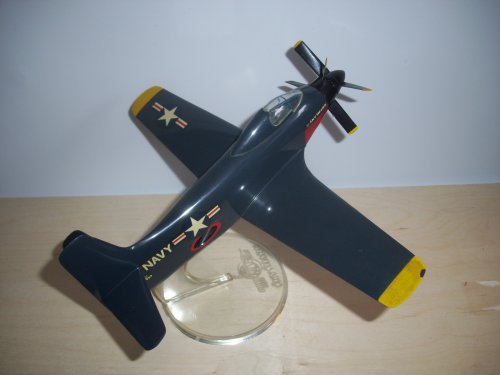 $T2eC16J,!)QE9s3HEEncBQPBk9WVgQ~~60_57.JPG330.2 KB · Views: 69
$T2eC16J,!)QE9s3HEEncBQPBk9WVgQ~~60_57.JPG330.2 KB · Views: 69 -
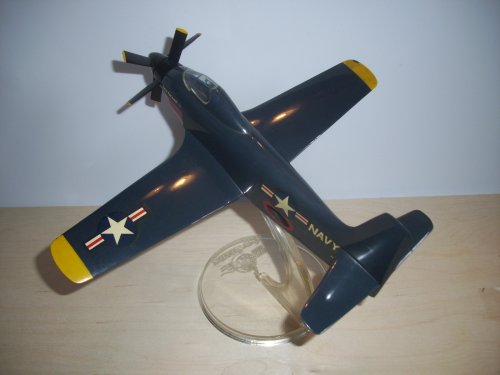 $T2eC16F,!)EE9s2ufFjpBQPBk5(3Qw~~60_57.JPG336 KB · Views: 71
$T2eC16F,!)EE9s2ufFjpBQPBk5(3Qw~~60_57.JPG336 KB · Views: 71 -
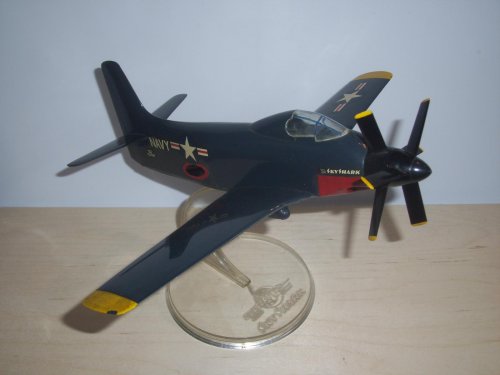 $(KGrHqZ,!qoE+nuCcjS6BQPBjM1YNw~~60_57.JPG101.1 KB · Views: 85
$(KGrHqZ,!qoE+nuCcjS6BQPBjM1YNw~~60_57.JPG101.1 KB · Views: 85
Does anyone know if there was any investigation into giving the Skyshark a swept wing at all?
- Joined
- 2 August 2006
- Messages
- 3,255
- Reaction score
- 1,527
GTX said:Does anyone know if there was any investigation into giving the Skyshark a swept wing at all?
I don't know of one, but I don't think it would have been a good idea, as the straight wing makes it easy to load all of those stores on the wing and keep the cg well within the control envelope. If you swept the wing then tried adding as many pylons, I think you would quickly run into cg loading problems or create more problems with regard to the ordnance would be placed along the span and in which sequence it could be used to maintain a proper cg.
Model of Douglas XA2D1 Skyshark manufactured by Allyn found on eBay.
URL:
http://www.ebay.com/itm/ALLYN-DOUGLAS-XA2D-1-SKYSHARK-DISPLAY-DESK-MODEL-ORIGINAL-NOT-MICROSCALE-/111074133470?pt=LH_DefaultDomain_0&hash=item19dc88c5de
URL:
http://www.ebay.com/itm/ALLYN-DOUGLAS-XA2D-1-SKYSHARK-DISPLAY-DESK-MODEL-ORIGINAL-NOT-MICROSCALE-/111074133470?pt=LH_DefaultDomain_0&hash=item19dc88c5de
Attachments
_Del_
I really should change my personal text... Or not.
- Joined
- 4 January 2012
- Messages
- 1,315
- Reaction score
- 1,811
Sundog said:GTX said:Does anyone know if there was any investigation into giving the Skyshark a swept wing at all?
I don't know of one, but I don't think it would have been a good idea, as the straight wing makes it easy to load all of those stores on the wing and keep the cg well within the control envelope. If you swept the wing then tried adding as many pylons, I think you would quickly run into cg loading problems or create more problems with regard to the ordnance would be placed along the span and in which sequence it could be used to maintain a proper cg.
And moving the wing root forward to keep the same center of lift would negatively impact visibility, I would assume.
- Joined
- 11 March 2006
- Messages
- 8,625
- Reaction score
- 3,804
_Del_ said:And moving the wing root forward to keep the same center of lift would negatively impact visibility, I would assume.
You may be right, although a bigger problem may have been, that the wing spar probably would have
run through the engine compartment.
Attachments
ksimmelink
Phormer Phantom Phixer
Jemiba said:_Del_ said:And moving the wing root forward to keep the same center of lift would negatively impact visibility, I would assume.
You may be right, although a bigger problem may have been, that the wing spar probably would have
run through the engine compartment.
But, what would happen if the wing remained straight to just outboard of the landing gear and then was swept? Or even was straight until the wingfold and then was swept? It would have been a compromise.
Douglas Skyraider model manufactured by Allyn in fair condition found on eBay.
Source:
http://www.ebay.com/itm/VINTAGE-Allyn-Models-DOUGLAS-A2D-SKYSHARK-DISPLAY-DESK-MODEL-Fair-CONDITION-/301348698960?pt=LH_DefaultDomain_0&hash=item4629c83b50
Source:
http://www.ebay.com/itm/VINTAGE-Allyn-Models-DOUGLAS-A2D-SKYSHARK-DISPLAY-DESK-MODEL-Fair-CONDITION-/301348698960?pt=LH_DefaultDomain_0&hash=item4629c83b50
Attachments
Douglas Skyshark model by Allyn (Fair condition)
Model of Douglas Skyshark manufactured by Allyn found on eBay. Fair condition?
Source:
http://www.ebay.com/itm/VINTAGE-Allyn-Models-DOUGLAS-A2D-SKYSHARK-DISPLAY-DESK-MODEL-Fair-CONDITION-/301501922164?pt=LH_DefaultDomain_0&hash=item4632ea3b74
Model of Douglas Skyshark manufactured by Allyn found on eBay. Fair condition?
Source:
http://www.ebay.com/itm/VINTAGE-Allyn-Models-DOUGLAS-A2D-SKYSHARK-DISPLAY-DESK-MODEL-Fair-CONDITION-/301501922164?pt=LH_DefaultDomain_0&hash=item4632ea3b74
Attachments
Allyn model of Douglas XA2D-1 Skyshark
Model of Douglas XA2D-1 Skyshark found eBay.
Source:
http://www.ebay.com/itm/ALLYN-VINTAGE-1950s-DOUGLAS-XA2D-1-SKYSHARK-DESK-MODEL-/292032930304?hash=item43fe84e200:g:Xr8AAOSwdGFYqemk
Model of Douglas XA2D-1 Skyshark found eBay.
Source:
http://www.ebay.com/itm/ALLYN-VINTAGE-1950s-DOUGLAS-XA2D-1-SKYSHARK-DESK-MODEL-/292032930304?hash=item43fe84e200:g:Xr8AAOSwdGFYqemk
Attachments
- Joined
- 11 March 2011
- Messages
- 307
- Reaction score
- 1,194
Just a note: In my 25 years basing out of Chino flying warbirds, one of the airframes that looked to be about 80% complete but sans cowl and engine sat on the main ramp at Chino acting as a pigeon roost. I don't recall the owners name, but he was trying to trade it to the Navy for something flyable. I taxied past it many times and stoped to lookie loo on many an occasion According the the Internet it was Douglas A2D Skyshark, BuNo 125485. BuNo 125485 is the sole survivor of the type. It was never flown, but it served as a ground radar calibration target at Los Angeles International Airport. It was later donated to the Ontario Air Museum. Here are some picts of it on the flightline of the Chino Airport dated October 18, 1987 and with the prop added dated Oct 17, 1993. Subsequently, the Skyshark was trucked to the Idaho Falls Airport where is was restored to static display. It was always fun to look at it when I taxied by and glad to hear it is still around and displayable.
Attachments
ZacYates
LHX SuperTeam fanboy
- Joined
- 26 December 2012
- Messages
- 156
- Reaction score
- 136
There are a few photos of the restored BuNo 125485 out there:
 Douglas A2D-1 Skyshark by linda m bell, on Flickr
Douglas A2D-1 Skyshark by linda m bell, on Flickr
 Douglas A2D-1 Skyshark by linda m bell, on Flickr
Douglas A2D-1 Skyshark by linda m bell, on Flickr
 Douglas A2D-1 Skyshark by linda m bell, on Flickr
Douglas A2D-1 Skyshark by linda m bell, on Flickr Douglas A2D-1 Skyshark by linda m bell, on Flickr
Douglas A2D-1 Skyshark by linda m bell, on Flickr- Joined
- 16 February 2013
- Messages
- 132
- Reaction score
- 605
. I have spent the last 45 years researching the T38/T40 engines and the aircraft they powered or were to power. I’ll skip a lot and get to the meat. When Allison began work on the dual power plant engine it designated it the Model 500. After they knew it was to progress further they designated one power section the Model 501 for speedier development. The Navy did it in reverse since they only got hard data on the single power section first they submitted a request to the Army Air Force (who managed all engine designations) and it was assigned T38 (all even numbers being Navy programs all odd numbers being Army Air Force). When Allison was able to provide hard engineering data on the dual powered engine the Navy requested another designation and was given T40. Please note that they are reversed sequentially, the Model 500 is the T40 and the Model 501 is the T38. The Allison plant was an Air Force managed plant. Now if you explore the T54 and the T56 you will see that they are still listed by Allison as the Model 500 and 501. Why??? Because they are. As a budget restriction and with the T40 going into production the Navy terminated the contract for the T38 and no longer financed it. This posed a problem for the Navy later as the T40 design was improved and it was decided the Navy also needed T38’s for several helicopter programs but that’s another story. The only difference between the T38 and T56 was the deletion of three of the compressor stages from 17 to 14 and the deletion of the individual combustion chamber and fuel nozzles from eight to six. But the only place you will count six on a T56 is on the Renwal T-56 plastic model which has six combustion chambers as the actual T56 shrouded them all in a single circular casing.
The thread on the C-130 competition notes all ten contenders but one were T38 or T40 powered yet it flew with the T-56! I have yet to find out if the now Air Force resubmitted for the T56 destination or the Navy did at the Air Force’s request. But just like the B-29/B50 thing, its easier to start a new program than restart an old one. It being that the advanced T38 was relabeled the T56 hence the T40 could not remain the T40 with T56 power sections so was given the T54 designation.
Just like the aircraft, P-51A, B, C, D & H are all Mustangs, the same goes with the engines. The designation stays the same with just variations like the Model 500-A-2, 500-A-4, 500-C13 changed as the power output is increased through the use of new materials like carbon seals, revised air channels, deletion of compressor stages to a more optimism number, etc.
The Rolls Royce (Allison) Heritage Trust group in Indianapolis is made up primarily of retired Allison engineers. When I said I thought the 500-A-8 was the same as the T54 the president started laughing and said, “of course it is, but few people know it.”
Retired Allison/Rolls Royce engineer John Leonard of the RR Heritage Trust put out an excellent book titled “The Allison Engine Catalog” (2008). I quote from page 61: “The T54 was originally called the T40-A-8 or the Allison Model 500-C. All T40s were Allison model 500-A or 500-B. The T40 and T56 were similar except the T54 used the T56 power sections and thus was more powerful.” It was all one program with four designations the difference being either one or two identical power sections.
The death kneel was too much new technology into one engine; electronic fuel controls, high speed dual rotation propellers, synthetic oils, complex gear boxes. Someone will say ‘but the British did it. NO the British did not do it. The dual rotation propellers such as on the ASW Gannet have a gear box where each engine drives a single propeller. Loose an engine – loose a propeller. No meshing between engines or propellers. The Allison gearbox took two drive shafts of 13,820 rpm and ran them through a gear box that then merged them and ran them to dual propellers.
The thread on the C-130 competition notes all ten contenders but one were T38 or T40 powered yet it flew with the T-56! I have yet to find out if the now Air Force resubmitted for the T56 destination or the Navy did at the Air Force’s request. But just like the B-29/B50 thing, its easier to start a new program than restart an old one. It being that the advanced T38 was relabeled the T56 hence the T40 could not remain the T40 with T56 power sections so was given the T54 designation.
Just like the aircraft, P-51A, B, C, D & H are all Mustangs, the same goes with the engines. The designation stays the same with just variations like the Model 500-A-2, 500-A-4, 500-C13 changed as the power output is increased through the use of new materials like carbon seals, revised air channels, deletion of compressor stages to a more optimism number, etc.
The Rolls Royce (Allison) Heritage Trust group in Indianapolis is made up primarily of retired Allison engineers. When I said I thought the 500-A-8 was the same as the T54 the president started laughing and said, “of course it is, but few people know it.”
Retired Allison/Rolls Royce engineer John Leonard of the RR Heritage Trust put out an excellent book titled “The Allison Engine Catalog” (2008). I quote from page 61: “The T54 was originally called the T40-A-8 or the Allison Model 500-C. All T40s were Allison model 500-A or 500-B. The T40 and T56 were similar except the T54 used the T56 power sections and thus was more powerful.” It was all one program with four designations the difference being either one or two identical power sections.
The death kneel was too much new technology into one engine; electronic fuel controls, high speed dual rotation propellers, synthetic oils, complex gear boxes. Someone will say ‘but the British did it. NO the British did not do it. The dual rotation propellers such as on the ASW Gannet have a gear box where each engine drives a single propeller. Loose an engine – loose a propeller. No meshing between engines or propellers. The Allison gearbox took two drive shafts of 13,820 rpm and ran them through a gear box that then merged them and ran them to dual propellers.
acegeek9992
ACCESS: Confidential
- Joined
- 25 March 2021
- Messages
- 111
- Reaction score
- 77
I guess we'll never know, but a T56 Skyshark definitely would be a great CAS aircraft thanks to all the weight it can sling and the fact that it has an engine that isn't complete dogshitWhy doesn't someone put a T56 in this and bid it for the USAF light attack (OA-X) requirement? A Sandy for 21st century wars...
F.L.
ACCESS: Top Secret
apparition13
I really should change my personal text
- Joined
- 27 January 2017
- Messages
- 604
- Reaction score
- 1,107
As I understand it the engines were fine, it had the same gearbox Achilles heel as the Freedom class LCS. Too much power flowing through gearing too weak to take it.I guess we'll never know, but a T56 Skyshark definitely would be a great CAS aircraft thanks to all the weight it can sling and the fact that it has an engine that isn't complete dogshitWhy doesn't someone put a T56 in this and bid it for the USAF light attack (OA-X) requirement? A Sandy for 21st century wars...
The question I have is why two engines in the first place? It's not like they are armored so one can keep going if the other is disabled by fire. I don't know much about early jet engines so I can't speculate as to what might be a good fit for a single engine driving both props, but someone else might be be able to make a suggestion. 5500 shp and 2500 pounds, any candidates?
acegeek9992
ACCESS: Confidential
- Joined
- 25 March 2021
- Messages
- 111
- Reaction score
- 77
The T40 was basically two T38s bolted together, with the plan being to have the pilot turn off one of the power sections during cruising flight for fuel efficiency and use the other section only if necessary. Of course, we all know how well that turned out...As I understand it the engines were fine, it had the same gearbox Achilles heel as the Freedom class LCS. Too much power flowing through gearing too weak to take it.I guess we'll never know, but a T56 Skyshark definitely would be a great CAS aircraft thanks to all the weight it can sling and the fact that it has an engine that isn't complete dogshitWhy doesn't someone put a T56 in this and bid it for the USAF light attack (OA-X) requirement? A Sandy for 21st century wars...
The question I have is why two engines in the first place? It's not like they are armored so one can keep going if the other is disabled by fire. I don't know much about early jet engines so I can't speculate as to what might be a good fit for a single engine driving both props, but someone else might be be able to make a suggestion. 5500 shp and 2500 pounds, any candidates?
Firefinder
ACCESS: Top Secret
- Joined
- 5 October 2019
- Messages
- 1,048
- Reaction score
- 1,900
To be fair the general idea did work.The T40 was basically two T38s bolted together, with the plan being to have the pilot turn off one of the power sections during cruising flight for fuel efficiency and use the other section only if necessary. Of course, we all know how well that turned out...As I understand it the engines were fine, it had the same gearbox Achilles heel as the Freedom class LCS. Too much power flowing through gearing too weak to take it.I guess we'll never know, but a T56 Skyshark definitely would be a great CAS aircraft thanks to all the weight it can sling and the fact that it has an engine that isn't complete dogshitWhy doesn't someone put a T56 in this and bid it for the USAF light attack (OA-X) requirement? A Sandy for 21st century wars...
The question I have is why two engines in the first place? It's not like they are armored so one can keep going if the other is disabled by fire. I don't know much about early jet engines so I can't speculate as to what might be a good fit for a single engine driving both props, but someone else might be be able to make a suggestion. 5500 shp and 2500 pounds, any candidates?
The Brits did similar with the Garnet Armstrong Siddeley Double Mamba with success.
It was just bad gearbox that screwed the T40.
Similar threads
-
-
-
McDonnell Douglas MD Helicopter Projects
- Started by hesham
- Replies: 41
-
Warren-Young Skycar tailless aircraft
- Started by hesham
- Replies: 10
-
Flightglobal Airbridge biplane project of 1950
- Started by hesham
- Replies: 1

